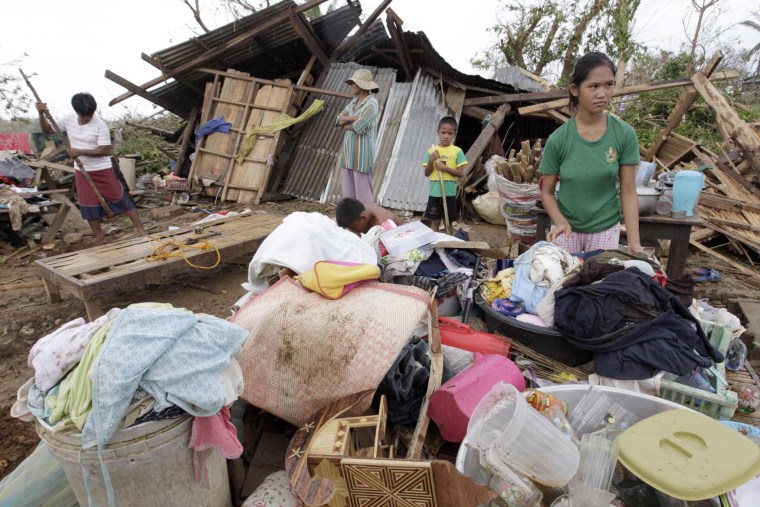A super typhoon that killed 13 people and flattened forests in the northern Philippines dumped heavy rains on the capital Tuesday as it headed across the sea to menace its next likely targets in southern China.
Forecasters expect Typhoon Megi to hit China's southern Guangdong province on either Friday or Saturday after picking up strength over the South China Sea, state news agency Xinhua said, adding it would be the strongest storm to hit China this year.
The typhoon would also affect the southern resort island of Hainan, where Xinhua reported 140,000 had already evacuated, and the region of Guangxi.
Floods were also reported in Vietnam and Thailand's northeast, where thousands of people have been left homeless and four people have died so far.
In the Philippines, disaster agency officials were trying to reach eastern coastal towns and villages, saying most houses appear to have been destroyed. Megi — the strongest storm this year — hit land as a category 5 super typhoon with winds in excess of 155 mph on Monday.
President Benigno Aquino III said Tuesday that although the typhoon caused significant damage, the loss of life in the country of some 94 million was minimal and "could have been much greater had we not prepared for the storm." Initial assessments showed lighter damage and casualties than expected, partly because the storm struck sparsely populated areas.
"The work of bringing life back to normal in the soonest possible time is already under way," Aquino said.
'Thought it was our last day'
Food vendor Nesie Callaotit, her husband and two children were hurriedly packing clothes to flee to safety when the wind yanked off half of their tin roof, exposing their house in northeastern Isabela province to pounding rain and the horrifying wind.
They held on to a wooden post for three hours, weeping and praying together, until the chaos eased.
"All of us were in tears," the 40-year-old Callaotit said. "We thought it was our last day together."
After it exited into the South China Sea on Tuesday, Megi was almost stationary packing winds of 108 mph but was forecast to regain strength before its expected landfall in southern China on Thursday. Chinese authorities evacuated 140,000 people from a coastal province.
The storm could also eventually hit Vietnam, which already was suffering from unrelated flooding that has killed 41 people.
On Monday, surging currents on Vietnam's flooded main highway swept away a bus and 19 of its passengers, including a boy pulled from his mother's grasp. Raging currents hampered search efforts on Tuesday.
Isabela province in the northeast Philippines, Megi's entry point, bore the brunt of the typhoon's destruction. Roads in and out of the coastal province were deserted and blocked by collapsed trees, power lines and debris and nearby coconut and banana groves were flattened.
Dramatic deaths reportedAuthorities blamed at least 10 deaths on the typhoon, including three men who drowned in a fish pond where the typhoon made landfall, a man who had slipped into a river after rescuing his water buffalo, a man killed by lightning and a mother killed along with her 4-year-old daughter and 2-year-old son after a tree collapsed on their home and pinned them to death.
Nearly 20 people were also injured, mostly by shattered glass panels, said executive director of the national disaster agency Benito Ramos, adding preparation and the evacuation of nearly 8,000 people had limited the loss of life.
The country stepped up efforts in light of a July typhoon that killed 102 people after it unexpectedly changed direction and sliced through Manila. The alleged lack of preparation prompted the president to fire the chief weather forecaster.
Iron-sheet roofs on many of the houses were blown away. In Tamauini town, Ariel Marzan said he escaped just minutes before his house tumbled amid winds so strong his roof was swept into a nearby rice field 30 yards away.
"I didn't expect it to be so strong," he said as he surveyed the damage and picked up the strewn pieces of his household.
Even as the typhoon moved away, its massive outer bands still stretched over much of western Luzon and drenched the capital, Manila, and surrounding areas, snarling traffic and sending about 1,000 people out of their homes into temporary shelters.
Assistant Agriculture Secretary Salvador Salacup said an initial estimate of $36 million losses to rice and corn crops showed the damage was minimal. Cagayan Valley and Ilocos regions lost around 12 percent of their rice production for the season. Cagayan Valley alone accounts for 30 percent of the national rice output.
Vietnam, Thailand floods
In Vietnam, officials say up to 31.5 inches of rain have pounded areas in just a few days, forcing 126,000 people to flee their homes. Earlier flooding this month left more than 80 people dead or missing.
The Hong Kong Observatory said Megi was expected to hit land Thursday. An official from the press office of the China Meteorological Administration said the typhoon could hit the coastlines of Guangdong and Hainan provinces on Thursday or Friday.
The meteorologists issued a second-highest alert for potential wild winds and huge waves.
The death toll from flooding in Thailand rose to five on Tuesday. Downpours that started over the weekend have affected nearly 55,000 people in 17 central and northeastern provinces, according to the Disaster Prevention and Mitigation Department.
Education Minister Chinnaworn Boonyakiat said 167 schools in seven provinces were flooded, but damage was limited since school was not currently in session.
In hardest-hit Nakhon Ratchasima province in the northeast, the water levels forced one hospital to evacuate 1,300 patients to other hospitals in nearby provinces. In one district, three 6.6-foot alligators escaped from a farm located near a river that burst its banks. Two of them were subsequently captured.
